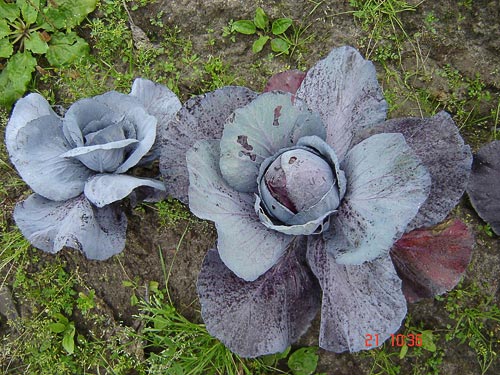Crops
Brassica oleracea L. convar capitata (L). Alef. var. capitata L. f. rubra (L.) Thell. [var. rubra (L). Thell] - Red Cabbage.
Taxonomic position.
Family Brassicaceae Burnett, genus Brassica L.Biology and morphology.
Biannual plant. Root system fibrillose, not very deep (30-50 sm). The short cabbage-stalk with rather short internodes is formed in the first year. Leaves are large, integral. Upper leaves are sessile, convexo-concave, from widelylanceolate till orbicular. Lower leaves are bended back, with leafstalk. Aggregate of leaves, densely overlapping each other, forms cabbage-head. Leaves are red or grey-violet with a waxen bloom, smooth, slightly rugose, dense. Head is short-oval, spherical or spherical-flat form. The economic validity of heads comes when they become dense, and top covering leaves have weak shine and colouring get becomes brighter-reddish or greenish-violet. Leaf-bearing pedunculed shoots up to 1,5 m height are developed from the buds on cabbage-stalk on the second year of vegetation. Inflorescence - cluster. Flowers are large, corolla is light yellow, sometimes almost white, till 2 cm diameter. Fruits - long pods (8-12 cm) with short beaks. Seeds are spherically-angular, up to 2 mm diameter, brown. 1000 seeds - 3-3,5 g.Grades form, size, thickness of cabbage-head, precocity.Grades differ by size of the basal rosette, height external cabbage-stalk and by size of heads (fine 10-15 cm, average of 16-25 cm, large 26-40 cm in diameter). Also there are grades middle ripening (economic ripeness for 125-155 day after shoots) and late-ripening (180-200 day after shoots). The most widespread grades: Kamennaja Golovka 447, Gako 741, Mikhnevskaja.
Distribution.
Wild species are not known. The origin of the species is related with Mediterranean genetic center. It is cultivated since an early neolith. All existing cultural forms of cabbage occur from one wild-growing kind of leaf cabbage Brassica sylvestris (L). Mill.. It was delivered to the Kiev Russia from Transcaucasia, beginning from 11-12 century seeds were delivered from Western Europe. It is universal culture, which is cultivated everywhere on agriculture lands.Ecology.
It is not very demanding to heat, suffers from high temperature much more, than from low temperature. Maintains frosts up to minus 5-7° C even as seedlings, but at long cold weather it can start flowering at the first year without head formation. Optimum temperature of growth 12-15° C. Plant of long day (more than 14 hours). It is requiring to moisture and more requiring to fertility of soil, than white head cabbage. Optimum value pH 6,0.Economic value.
Vegetable plant. Leaves are used in salads, for preparation of soups and the second courses, for salt and preserve products. Leaves contain 10 % dry substances, 4.5-6.0 % sugars, vitamins A, C, B1, B2. High amount of cianids influences salutarily on vascular system. Productivity 20-40 tonn per hectare.The literature.
Cabbage. Composer D.A.Starikova. Novosibirsk, 1989Dzhohadze T.I., Kravets L.A. Cabbage red head, savoy, bruxelles, broccoli. Leningrad, 1983
Rusanov B.G. Cabbage. St.-Petersburg, 2000
Vehov V.N., Gubanov I.A., Lebedeva G.F. Cultural plants of the USSR. Moscow 1978
Zhukovskij P.M. Cultural plants and their relatives. Leningrad. 1971


